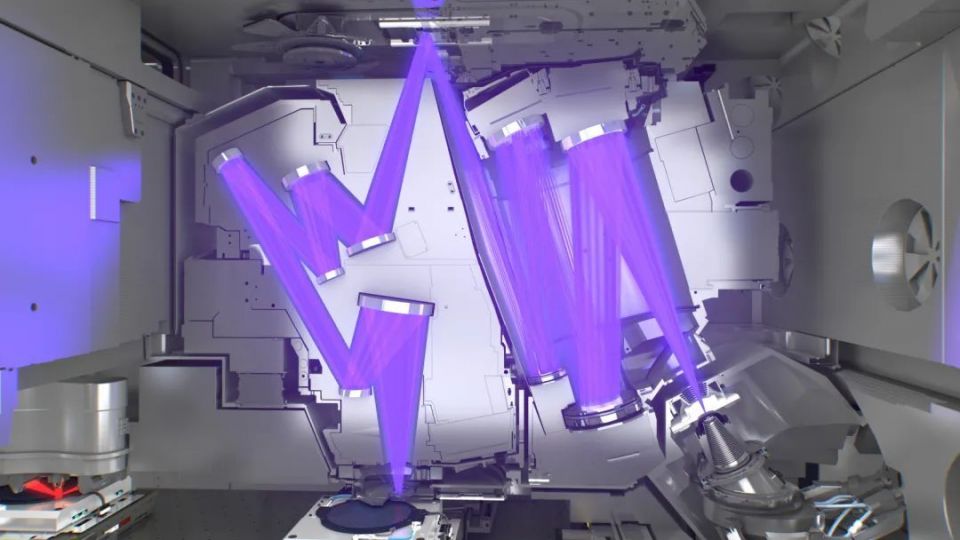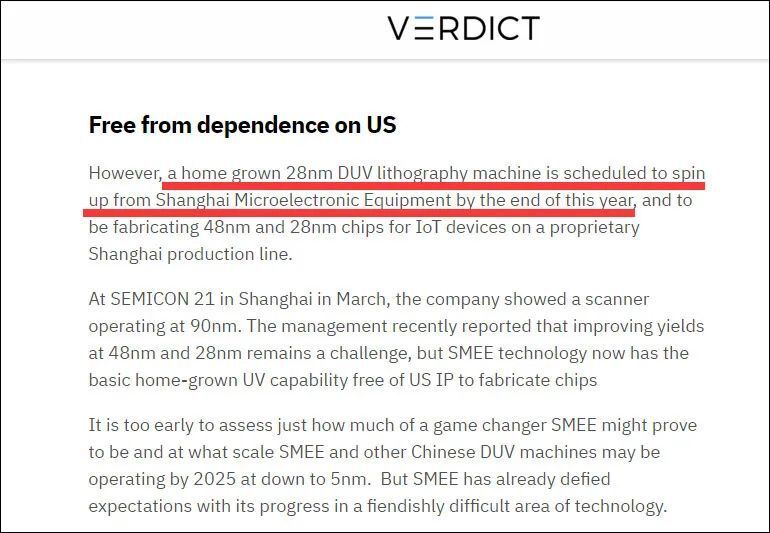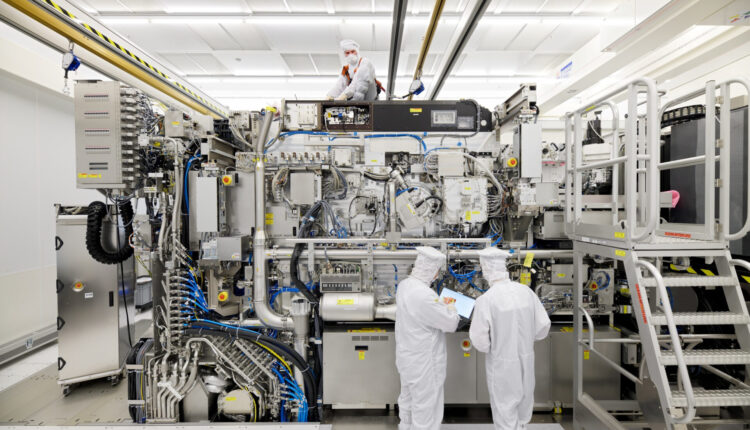Extreme Ultraviolet Photolithography Machine (EUV) is an indispensable tool for the development of chip technology below 7nm, with an average price of more than 1.2 billion yuan per unit.
SMIC International needs to use EUV to make more advanced chips, and Dutch photolithography machines giant ASML also hopes to sell more equipment to dilute research and development costs. However, due to the obstruction of the United States, the two sides have been unable to complete the transaction.
“Export controls will accelerate China’s independent research and development, and they will do everything in 15 years” “After China takes full control of the supply chain, European suppliers will completely lose the market.” Despite Asmael CEO Wen Peter’s successive expressions of anxiety, the United States still chooses to turn a blind eye.
According to the U.S. media The Wall Street Journal on July 17, an American official revealed that the Biden administration chose to continue the Trump-era policy after confirming the strategic value of EUV lithography machines in the technology industry. White House officials have contacted the Dutch government and asked the Netherlands to restrict the sale of EUV to mainland China on national security grounds.
The report revealed that less than a month after Biden officially took office, his national security adviser Jack Sullivan has spoken to the Dutch side about “close cooperation on advanced technology”. U.S. officials revealed that it is Sullivan’s top priority to continue to restrict Asma’s cooperation with mainland China.
At present, only one Asmaer company in the world can produce EUV photolithography machines. Globally, whether it is Intel in the United States, Samsung in South Korea, or TSMC in Taiwan, China, they are free to buy 180 tons of EUV to make chips for high-end electronic equipment.
However, under pressure from the United States, the Dutch government has not approved the export of EUV to mainland China.
U.S. pressure on the Dutch government began as early as Trump’s term.
Charles Kupperman, then the deputy national security adviser to the United States, recalled that he invited Dutch diplomats to the White House in 2019 and pressured the latter that “faithful allies” would not sell equipment such as EUV to mainland China. Cooperman also warned the Netherlands that Asmaj’s equipment would not work without American parts, and the White House had the right to restrict the export of these parts to the Netherlands.

The report quoted people familiar with the matter as saying that restrictions on the export of technology to the Netherlands are not currently within the scope of discussion at the White House. But the United States is trying to bring together a coalition of Western countries to cooperate on export control issues. This move may have an impact on areas other than EUV lithography machines, further disrupting the already under pressure of semiconductor supply chains around the world.
Asmael Financial Report revealed that in the past 2020, the company’s revenue and shipments in mainland China have reached record highs. In the first quarter of 2021, Asmaek shipped about 11 lithography systems to mainland China, accounting for 15% of them third in the world (the top two are South Korea and Taiwan, China), but there is no EUV.
In the view of Asmay CEO Wen Peter, U.S. export control measures may backfire.
“Export control is an effective tool when it comes to targeted, specific national security issues,” Win Peter said in a statement. “However, as part of a broader national semiconductor leadership strategy, governments need to consider how these tools can be used too much by reducing investment in research and development. Slow down medium-term innovation.” He added that in the short and medium term, excessive use of export controls may reduce global chip manufacturing capacity and exacerbate supply chain problems.
The export of EUV to mainland China has not been approved, which has also caused a rift in Sino-Dutch relations. Citing people familiar with the matter, the Wall Street Journal said that Chinese officials often asked the Dutch government why “why did he grant Asmaek permission to transport equipment to mainland China”.
In December last year, a spokesman for the Chinese Embassy in the Netherlands pointed out that China firmly opposes any third party exerting political pressure on the Dutch government to force the Netherlands to make decisions against its own interests. This will inevitably lead to adverse consequences for all parties and will also have a negative impact on the international trade order.
Although photolithography machine is a difficult point in semiconductor equipment, mainland China has not given up independent research and development.
In June 2020, Founder Securities mentioned in a research report: “In the second phase of the National 02 Special Photolithography Machine Project, the set time is December 2020 to accept the 193nm ArF immersion DUV photolithography machine. Its process process is 28nm, and the target product is ASML’s strongest DUV at this stage. Photolithography machine: TwinscannXT:2000i. Taking NXT:2000i as an example, the subsystems are split as follows: Shanghai Microelectronics is responsible for the design and overall integration of photolithography machines, Beijing Keyi Hongyuan provides light source system, Beijing Guowang Optics provides objective lens system, Guoke Precision provides exposure optical system, Huazhuo Seiko provides dual workbench, Zhejiang Qier electromechanical provides immersion. System.”
On June 8 this year, the British technology media “VERDICT” said in a report that Shanghai Microelectronics plans to launch a domestic 28nm DUV lithography machine by the end of this year and manufacture 48nm and 28nm chips for Internet of Things devices on a proprietary production line in Shanghai. The report also mentioned that Shanghai Microelectronics management recently said that improving the yields of 48nm and 28nm is still a challenge, but the company now has basic independent photolithography machines technology capabilities, and does not need U.S. IP to make chips.
VERDICT commented that it is too early to evaluate the changes in the market rules of Chinese enterprises in the field of photolithography, but Shanghai Microelectronics has made a breakthrough in an extremely difficult technical field.
However, VERDICT did not disclose the specific source of information.
Analysts of CINNO Research, a market research institution, told Guancha.com that the information we have learned so far is that the most influential part of the research and development difficulties of photolithography machines are light sources and objective lenses, respectively from Keyi Hongyuan and Guowang Optics in Beijing. Among them, objective lens is the most difficult, and there is still a gap between Germany and Japan and many years of technical experience accumulation. It is quite difficult to catch up in a short period of time. In addition, in order to improve the autonomy of subsystems and components, and to counter the “stuck neck” of the United States, the whole system needs more time to improve.

On July 14, the Shanghai Municipal Government issued the “14th Five-Year Plan for the Development of Shanghai Advanced Manufacturing Industry”. It is mentioned that during the 14th Five-Year Plan period, the innovation and development of equipment materials will be strengthened, and the core process equipment of integrated circuit front-channel such as photolithography machine, etching equipment, thin film equipment, ion injection equipment, wet equipment, detection equipment, etc.
Perhaps seeing China’s determination to break through semiconductor equipment, Asmael CEO Wen Peter shouted to the United States in April this year, “If you take export control measures to exclude the Chinese market, it will force them to fight for technological sovereignty, on their real skills. In terms of sovereignty… in 15 years, they will be able to make all these things themselves, and their market (the market for European suppliers) will disappear completely.
The Wall Street Journal believes that it will take at least 10 years for China to catch up with Asmaj’s photolithography machines technology.

